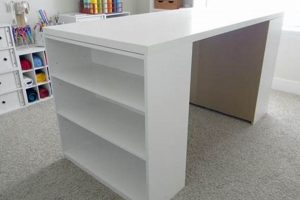A self-created compilation of images and/or text, bound in a visually appealing format, designed for display on a centrally located surface in a living space. A collection of personal travel photographs assembled and printed as a showcase volume serves as an example of such a project.
Such individualized creations offer significant personalization in decor and represent a unique expression of interests or experiences. Historically, the prevalence of mass-produced books led to a renewed appreciation for handmade and customized objects, driving interest in this type of project.
The following sections will explore the various aspects of crafting these personalized volumes, from material selection to binding techniques, and discuss strategies for effective visual storytelling within their pages.
Crafting a Visually Compelling Display Volume
Producing a refined and engaging display volume requires careful consideration of design principles and execution. The following tips provide guidance on creating a memorable and aesthetically pleasing piece.
Tip 1: Establish a Clear Theme. A unifying concept ensures cohesion. Focus on a single subject matter, geographic location, or personal narrative to maintain visual and thematic consistency.
Tip 2: Prioritize High-Resolution Imagery. Images must be of sufficient quality to withstand enlargement. Original, high-resolution photographs or professionally scanned images are crucial for optimal print results.
Tip 3: Implement Consistent Layouts. Employ a limited number of layout templates for page design. Repetitive design elements create visual rhythm and improve readability.
Tip 4: Select a Complementary Typography. Choose fonts that align with the subject matter and overall aesthetic. Limit the number of fonts used to avoid visual clutter; consider serif fonts for body text and sans-serif fonts for headings.
Tip 5: Proofread Extensively. Textual content should be free of errors in grammar, spelling, and punctuation. Professional proofreading ensures a polished and credible final product.
Tip 6: Consider Paper Stock and Binding. The choice of paper affects the tactile experience and perceived quality. Consider matte paper for reduced glare and lay-flat binding for optimal viewing.
Tip 7: Plan for Image Sequencing and Pacing. Strategic arrangement of images creates visual interest and guides the viewer through the narrative. Varying image sizes and incorporating whitespace enhances the viewing experience.
The application of these principles will result in a finished product that effectively communicates its intended message while enhancing the aesthetic appeal of its display environment.
The subsequent section will delve into the process of selecting materials and binding options to further refine the final product.
1. Theme Selection
The selection of a unifying theme is fundamental to the success of a self-made display volume. It provides a guiding principle for content selection, design elements, and overall aesthetic, ensuring a cohesive and engaging final product.
- Content Curation and Focus
A well-defined theme streamlines the content curation process. By establishing clear parameters for inclusion, the theme prevents irrelevant or disjointed elements from compromising the narrative flow. For example, a theme centered on “Urban Architecture” would necessitate the exclusion of landscape photography, regardless of its individual merit.
- Design Cohesion
The chosen theme directly informs design decisions, including font selection, color palettes, and layout styles. A theme focused on vintage aviation might suggest the use of sepia tones, classic serif fonts, and layouts reminiscent of historical documents, contributing to a unified visual experience.
- Audience Engagement and Resonance
A compelling theme resonates with the intended audience, enhancing their engagement and appreciation. A volume dedicated to “Family History,” for example, holds intrinsic value for family members, fostering a connection that transcends mere aesthetic appeal.
- Narrative Structure and Flow
The theme provides a framework for constructing a coherent narrative. A theme based on a specific journey or project allows for a chronological or process-oriented structure, guiding the viewer through a logical progression of images and text.
In summation, theme selection is not merely an initial decision but a cornerstone upon which the entire creation rests. It dictates the content, influences the design, engages the audience, and shapes the narrative, ultimately defining the success and impact of the display volume.
2. Image Quality
The quality of images fundamentally determines the visual impact and overall success of a self-made display volume. Inferior image resolution, poor color reproduction, or inadequate sharpness directly detract from the perceived value and aesthetic appeal of the finished product, diminishing its function as a statement piece. For example, a collection of low-resolution digital photographs, even if artistically composed, will appear pixelated and unprofessional when printed at a larger scale suitable for a display volume.
Furthermore, image quality affects the narrative effectiveness of the volume. Blurry or poorly exposed images can obscure details crucial to the story being conveyed, hindering the viewer’s ability to connect with the content. In contrast, high-quality images with accurate colors and sharp details enhance the viewing experience, allowing the viewer to fully appreciate the artistry and craftsmanship of both the images themselves and the overall creation. Consider a professionally printed photography book where the sharpness, clarity, and color fidelity of each photograph allows the viewer to fully appreciate the photographer’s artistry and vision. The same principle applies, albeit on a personalized scale, to a self-made volume.
In conclusion, prioritizing image quality is not merely an aesthetic consideration, but a critical component in achieving a visually compelling and narratively engaging self-made display volume. The challenges of ensuring high image quality, particularly when working with older or low-resolution sources, can be addressed through careful scanning, digital enhancement techniques, and prudent selection of printing services specializing in high-quality image reproduction. The investment in image quality directly translates to a more impactful and enduring finished product.
3. Layout consistency
The integration of consistent layout principles directly influences the perceived professionalism and visual appeal of a self-assembled display volume. Without a unifying layout strategy, a collection of images and text may appear disjointed and amateurish, detracting from the viewer’s engagement and undermining the overall aesthetic intent. A lack of consistent margins, inconsistent font sizes, or haphazard image placement can create visual clutter, hindering readability and diminishing the intended impact of the presented content. For example, a chronicle of family history could be compromised by inconsistencies in photo sizes and text styles; the book could lose its storytelling intent and appear disorderly, disrupting its emotional impact.
Adhering to a limited set of pre-defined layout templates provides a framework for organizing content in a visually predictable and pleasing manner. Consistent use of margins, column widths, and image alignment creates a sense of order and visual harmony, guiding the viewer’s eye through the pages. By implementing a clear visual hierarchy, layout consistency enhances readability and facilitates comprehension. For instance, headings and subheadings consistently formatted throughout the volume enable the reader to quickly navigate and identify key information. This structured approach allows the content, such as travel photos, to be showcased efficiently without distracting, thus maximizing its beauty, narrative power, and visual engagement.
In conclusion, layout consistency serves as a cornerstone of effective design in self-made display volumes. Its implementation contributes to a refined and professional presentation, enhancing readability, visual appeal, and overall impact. Challenges in achieving layout consistency, particularly with diverse source materials, can be mitigated through the use of design software with pre-set templates and careful attention to detail during the assembly process. This investment in design precision is crucial for transforming a collection of individual elements into a cohesive and compelling narrative.
4. Typography choice
The selection of appropriate typography is a critical element in the production of a self-made display volume. The chosen fonts significantly influence the readability, aesthetic appeal, and overall tone of the finished product. Incompatible or poorly chosen fonts can undermine the visual harmony and detract from the intended message, regardless of the quality of the images or content.
For example, a display volume showcasing a collection of modern art might benefit from clean, sans-serif fonts that complement the minimalist aesthetic. Conversely, a volume dedicated to historical documents or classic literature might employ serif fonts that evoke a sense of tradition and elegance. The application of different fonts can affect the readability and make a book easier to read and view, depending on its content and goal. Consider the impact of these choices on the viewing experience. Poor typography can result in visual fatigue and disinterest, while well-chosen fonts can enhance engagement and comprehension, making the volume a more enjoyable and effective medium for conveying its message.
In conclusion, thoughtful typography selection is integral to the success of a self-made display volume. It requires careful consideration of the subject matter, intended audience, and overall design aesthetic. Prioritizing legibility and visual harmony will result in a polished and professional final product that effectively communicates its intended message. The time and effort invested in font selection directly contributes to the perceived value and long-term appeal of the completed project.
5. Content accuracy
In the context of a self-made display volume, content accuracy assumes critical importance. Any factual errors, misrepresentations, or inconsistencies within the textual elements of the book directly undermine its credibility and diminish its value as a source of information or personal expression. For example, a family history project riddled with incorrect dates, names, or genealogical information would compromise its historical accuracy and render it unreliable for future generations. This illustrates the potential damage caused by neglecting rigorous fact-checking.
The accuracy of visual content, particularly in image captions or descriptive text, is equally paramount. Misidentified locations, misrepresented historical events, or incorrect attribution of authorship can lead to misinformation and erode the viewer’s trust in the overall presentation. Consider a display volume showcasing travel photography. Inaccurate labeling of landmarks or cultural sites not only misinforms the reader but also diminishes the educational value of the book. Similarly, if creating a biographical display volume for a relative, the dates and locations of births, deaths, and marriages would need to be factual.
In conclusion, meticulous attention to content accuracy is an indispensable element in the creation of a self-made display volume. While aesthetic considerations play a significant role in its appeal, the book’s credibility rests upon the veracity of its content. The process of verifying facts, cross-referencing sources, and engaging in thorough proofreading is essential for ensuring the long-term value and integrity of the final product. Ignoring content accuracy presents a significant challenge, potentially rendering the volume a source of misinformation rather than a cherished keepsake or informative resource.
6. Binding method
The selection of an appropriate binding method is a crucial determinant of the structural integrity, aesthetic appeal, and long-term durability of a self-made display volume. The binding method dictates how the individual pages are joined together, directly influencing the book’s ability to withstand handling, resist damage, and maintain its intended visual presentation over time.
- Lay-Flat Binding
Characterized by pages that lie completely flat when opened, this method is particularly suited for display volumes featuring full-page images or spreads. It allows for uninterrupted viewing of visual content without the distortion caused by a curved spine. Example: A photography-based display volume benefits significantly from lay-flat binding, allowing viewers to appreciate panoramic images without obstruction. The method is expensive, however, and can be difficult to achieve for a novice.
- Case Binding (Hardcover)
A robust and durable binding method, case binding involves sewing the sections of the book together and adhering them to a rigid cover. It provides enhanced protection against wear and tear, making it suitable for volumes intended for frequent handling or long-term preservation. Example: A family history project intended for multiple generations would benefit from the durability offered by case binding. Skilled craftsmanship is required.
- Saddle Stitch Binding
This cost-effective method is suitable for shorter volumes with a relatively small number of pages. The pages are folded in half and secured through the fold line with staples or stitches. However, saddle stitch binding is not ideal for thicker volumes as it can cause the pages to bulge and may not provide sufficient structural support. Example: A display volume featuring a limited selection of travel photographs could utilize saddle stitch binding, provided the page count remains relatively low.
- Spiral Binding (Coil Binding)
A flexible and relatively inexpensive method, spiral binding uses a plastic or metal coil to hold the pages together. It allows the volume to lie flat and facilitates easy page turning. However, spiral binding is generally considered less aesthetically refined than other methods and may not be suitable for formal or archival display volumes. Example: A self-made cookbook could benefit from spiral binding, allowing the pages to lie flat on a countertop for easy reference during cooking.
In conclusion, the selection of a binding method should be carefully considered based on the intended use, aesthetic requirements, and budget constraints of the self-made display volume. Each method offers unique advantages and disadvantages, and the optimal choice depends on the specific characteristics of the project. The binding method serves as a crucial bridge between the content and the visual presentation, significantly influencing the long-term value and impact of the finished product.
7. Sequencing strategy
Within the context of a self-assembled display volume, the sequencing strategy represents a critical factor in shaping the narrative flow and overall impact of the finished product. The arrangement of contentimages, text, and graphic elementsexerts a direct influence on viewer engagement and comprehension. A well-considered sequencing strategy facilitates a coherent narrative, guiding the viewer through the volume in a logical and aesthetically pleasing manner. Conversely, a haphazard or illogical sequence can disrupt the flow, confuse the viewer, and diminish the book’s effectiveness as a storytelling medium. The impact of sequencing can be understood through considering examples from various disciplines, such as the cause-and-effect relationship within a well-structured documentary.
To illustrate, consider a display volume documenting a personal journey. Chronological sequencing offers a straightforward approach, allowing the viewer to follow the traveler’s itinerary and experience events in the order they occurred. Alternatively, a thematic sequencing strategy might group images and text based on recurring motifs, emotions, or concepts, creating a more nuanced and interpretive narrative. A volume showcasing architectural photography could employ a spatial sequencing strategy, organizing images by location or building type. The practical significance lies in the ability to tailor the viewing experience to achieve specific artistic or communicative goals, impacting content absorption.
In summary, the sequencing strategy is not merely a matter of arbitrary arrangement but a deliberate act of curatorial design. Challenges in implementing an effective strategy may arise from diverse content or complex narratives, demanding careful planning and experimentation. The ability to manipulate the viewing experience through thoughtful sequencing transforms a collection of disparate elements into a cohesive and compelling whole, enhancing the aesthetic and communicative power of the self-made display volume. Therefore, this crucial aspect must be carefully considered in the creation of such projects, thus adding value to the end-result.
Frequently Asked Questions About DIY Coffee Table Books
This section addresses common inquiries and concerns regarding the creation of self-made display volumes, offering concise and informative answers based on industry best practices.
Question 1: What are the essential software tools needed for designing a DIY coffee table book?
Professional-grade design software, such as Adobe InDesign or Affinity Publisher, provides the necessary layout and typography controls. Alternatively, user-friendly online platforms like Canva or Blurb offer simplified design interfaces.
Question 2: What is the optimal image resolution for printing high-quality photographs in a DIY coffee table book?
Images should ideally be at least 300 dots per inch (DPI) at the intended print size. Lower resolutions may result in pixelation or blurring, compromising the visual clarity of the photographs.
Question 3: How can color accuracy be ensured when printing a DIY coffee table book?
Utilize a color-managed workflow, calibrating the monitor and printer to industry standards. Request a proof print from the printing service to verify color accuracy before committing to a full print run.
Question 4: What are the key considerations when selecting a printing service for a DIY coffee table book?
Evaluate the printing service’s expertise in producing high-quality books, their paper stock options, binding methods, and customer reviews. Obtain quotes from multiple providers to compare pricing and services.
Question 5: How can copyright issues be avoided when incorporating third-party content into a DIY coffee table book?
Obtain explicit permission from the copyright holder for any copyrighted text, images, or other materials. Alternatively, utilize royalty-free or Creative Commons licensed content, ensuring compliance with the licensing terms.
Question 6: What are the common mistakes to avoid when designing and printing a DIY coffee table book?
Avoid neglecting proofreading, using low-resolution images, choosing incompatible fonts, and failing to account for bleed areas. Meticulous planning and attention to detail are crucial for achieving a professional-looking final product.
In summary, careful planning, attention to technical details, and adherence to best practices are essential for creating a successful DIY coffee table book.
The next section will provide a comprehensive checklist for ensuring quality and completeness before final production.
diy coffee table book Conclusion
This exploration has detailed essential aspects of producing a self-made display volume, ranging from theme selection and image quality to layout consistency, typography, content accuracy, binding methods, and sequencing strategies. Each element contributes significantly to the overall impact and perceived value of the finished product. Diligence in these areas is paramount for transforming a collection of disparate elements into a cohesive and compelling narrative.
The creation of a diy coffee table book represents a significant investment of time and resources. Therefore, it is imperative that individuals embarking on such a project approach it with a commitment to quality and attention to detail. The final product should serve as a testament to both the creator’s vision and the enduring power of tangible, personalized storytelling. With careful planning and execution, these bespoke volumes can enrich environments and foster appreciation for the unique experiences and perspectives they encapsulate.







